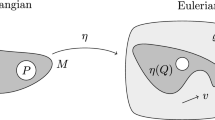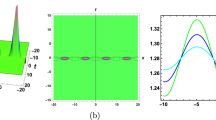Abstract
The balance system is called a labyrinth and it consists of three mutually orthogonal canals, called semicircular canals (SCCs). The SCCs are filled with a fluid called endolymph, and each canal has a cupula that is deformed by the endolymph flow. One of the balance disorders is called benign paroxysmal positional vertigo, and one of the pathological conditions that cause this disorder is canalithiasis. Canalithiasis is caused by the free-moving otoconia particles within the SCC. In this study, a numerical model is presented that enables the analysis of motion of multiple otoconia particles within the labyrinth and the change of cupular displacement due to this motion. The three-dimensional endolymph flow is modeled using the specific adaptation of the lattice Boltzmann method, called the mass-conserved volumetric lattice Boltzmann method. The cupula is considered to be linearly elastic and modeled as a set of springs. The interaction between particles is modeled using the equation introduced in the DEM method. The interaction of the particles with the wall is modeled using a lubrication force. The interaction of all considered entities is modeled by interpolating the quantities of interest over the surrounding points. Results presented in this study are obtained using the patient-specific geometry, and the endolymph flow through the entire labyrinth is simulated. The good agreement of results presented in this study with results from the literature shows that this numerical model has the potential to be successfully used for simulations of processes occurring during canalithiasis in the semicircular canals.















Similar content being viewed by others
References
Obrist D, Hegemann S (2008) Fluid–particle dynamics in canalithiasis. J R Soc Interface 5:1215–1229
Squires TM, Weidmann MS, Hain TC, Stone HA (2004) A mathematical model for top-shelf vertigo: the role of sedimenting otoconia in BPPV. J Biomech 37:1137–1146
Baloh RW, Sloane PD, Honrubia V (1989) Quantitative vestibular function testing in elderly patients with dizziness. Ear Nose Throat J 68:935–939
Schuknecht HF (1962) Positional vertigo: clinical and experimental observations. Trans Am Acad Ophthalmol Otol 66:319–331
Hall SF, Ruby RR, McClure JA (1979) The mechanics of benign paroxysmal vertigo. J Otolaryngol 8:151–158
Parnes LS, McClure JA (1992) Free-floating endolymph particles: a new operative finding during posterior semicircular canal occlusion. Laryngoscope 102:988–992
Boselli F, Kleiser L, Bockisch CJ, Hegemann SCA, Obrist D (2014) Quantitative analysis of benign paroxysmal positional vertigo fatigue under canalithiasis conditions. J Biomech 47:1853–1860
Djukic T, Filipovic N (2017) Numerical modeling of the cupular displacement and motion of otoconia particles in a semicircular canal. Biomech Model Mechanobiol 16(5):1669–1680
Nooruddin FS, Turk G (2003) Simplification and repair of polygonal models using volumetric techniques. IEEE Trans Vis Comput Graph 9(2):191–205
Min P (2013) Binvox 3D mesh voxelizer. http://www.patrickmin.com/binvox. Accessed 20 Feb 2019
Yu H, Chen X, Wang Z, Deep D, Lima E, Zhao Y, Teague SD (2014) Mass-conserved volumetric lattice Boltzmann method for complex flows with willfully moving boundaries. Phys Rev E 89:063304
Đukić T (2015) Modeling motion of deformable body inside fluid and its application in biomedical engineering. Ph.D. Dissertation, Faculty of Engineering, University of Kragujevac, Serbia
Malaspinas OP (2009) Lattice Boltzmann method for the simulation of viscoelastic fluid flows. Ph.D. dissertation, Ecole Polytechnique Federale de Lausanne, Switzerland
Huang К (1987) Statistical mechanics. Wiley, New York
Filipovic N, Zivic M, Obradovic M, Djukic T, Markovic Z, Rosic M (2014) Numerical and experimental LDL transport through arterial wall. Microfluid Nanofluid 16(3):455–464
Filipović N, Isailović V, Đukić T, Ferrari M, Kojić M (2012) Multi-scale modeling of circular and elliptical particles in laminar shear flow. IEEE Trans Biomed Eng 59(1):50–53
Djukic T, Topalovic M, Filipovic N (2015) Numerical simulation of isolation of cancer cells in a microfluidic chip. J Micromech Microeng 25(8):084012
Djukic T, Karthik S, Saveljic I, Djonov V, Filipovic N (2016) Modeling the behavior of red blood cells within the caudal vein plexus of zebrafish. Front Physiol. https://doi.org/10.3389/fphys.2016.00455
Dupin M, Halliday I, Care C, Alboul L, Munn L (2007) Modeling the flow of dence suspensions of deformable particles in three dimensions. Phys Rev E Stat Nonlinear Soft Matter Phys 6(75):066707
Cooley MDA, O’Neill ME (1968) On the slow rotation of a sphere about a diameter parallel to a nearby plane wall. J Inst Math Appl 4:163–173
O’Neill ME, Stewartson K (1967) On the slow motion of a sphere parallel to a nearby plane wall. J Fluid Mech 27:705–724
Topalovic M (2016) Numerical modeling of granular materials. Ph.D. dissertation, Faculty of Engineering, University of Kragujevac, Serbia
Cook BK, Noble DR, Williams JR (2004) A direct simulation method for particle-fluid systems. Eng Comput 21:151–168
Feng YT, Han K, Owen DRJ (2007) Coupled lattice Boltzmann method and discrete element modelling of particle transport in turbulent fluid flows: computational issues. Int J Numer Methods Eng 72:1111–1134
Leonardi CR, McCullough JWS, Jones BD, William JR (2016) Electromagnetic excitation of particle suspensions in hydraulic fractures using a coupled lattice Boltzmann-discrete element model. Comput Particle Mech 3:125–140
Cundall PA, Strack OD (1979) A discrete numerical model for granular assemblies. Geotechnique 29:47–65
Padbidri J, Mesarovic S (2011) Acceleration of DEM algorithm for quasistatic processes. Int J Numer Methods Eng 86:816–828
Kezdi A (1974) Handbook of soil mechanics. Elsevier, Amsterdam
Peskin CS (1977) Numerical analysis of blood flow in the heart. J Comput Phys 25(3):220–252
Dix M, Hallpike C (1952) The pathology, symptomatology, and diagnosis of certain common disorders of the vestibular system. Proc R Soc Med 45:341–354
Van Buskirk W, Watts R, Liu Y (1976) The fluid mechanics of the semicircular canals. J Fluid Mech 78:87–98
Damiano E, Rabbitt R (1996) A singular perturbation model of fluid dynamics in the vestibular semicircular canal and ampulla. J Fluid Mech 307:333–372
Boselli F, Obrist D, Kleiser L (2013) Vortical flow in the utricle and the ampulla: a computational study on the fluid dynamics of the vestibular system. Biomech Model Mechanobiol 12(2):335–348
Rajguru SM, Rabbitt RD (2007) Afferent responses during experimentally induced semicircular canalithiasis. J Neurophysiol 97:2355–2363
Inagaki T, Suzuki M, Otsuka K, Kitajima N, Furuya M, Ogawa Y, Takenouchi T (2006) Model experiments of BPPV using isolated utricle and posterior semicircular canal. Auris Nasus Larynx 33:129–134
Suzuki M, Kadir A, Hayashi N, Takamoto M (1996) Functional model of benign paroxysmal positional vertigo using an isolated frog semicircular canal. J Vestib Res 6:121–125
Ifediba MA, Rajguru SM, Hullar TE, Rabbitt RD (2007) The role of 3-canal biomechanics in angular motion transduction by the human vestibular labyrinth. Ann Biomed Eng 35:1247–1263
Sun Q, Gan RZ, Chang K-H, Dormer KJ (2002) Computer-integrated finite element modeling of human middle ear. Biomech Model Mechanobiol 1(2):109–122
Rajguru SM, Ifediba MA, Rabbitt RD (2005) Biomechanics of horizontal canal benign paroxysmal positional vertigo. J Vestib Res 15:203–214
Yamauchi A, Rabbitt R, Boyle R, Highstein S (2001) Relationship between inner-ear fluid pressure and semicircular canal afferent nerve discharge. J Assoc Res Otolaryngol 3:24–44
Acknowledgements
This study was funded by Grants from Ministry of Education, Science and Technological Development of the Republic of Serbia (Projects Numbers III41007 and ON174028) and by European Commission, 7th Framework Programme FP7 ICT-2013-10 EMBalance Project.
Author information
Authors and Affiliations
Corresponding author
Ethics declarations
Conflict of interest
The authors declare that they have no conflict of interest.
Additional information
Publisher’s Note
Springer Nature remains neutral with regard to jurisdictional claims in published maps and institutional affiliations.
Rights and permissions
About this article
Cite this article
Djukic, T., Saveljic, I. & Filipovic, N. Numerical modeling of the motion of otoconia particles in the patient-specific semicircular canal. Comp. Part. Mech. 6, 767–780 (2019). https://doi.org/10.1007/s40571-019-00260-1
Received:
Accepted:
Published:
Issue Date:
DOI: https://doi.org/10.1007/s40571-019-00260-1




